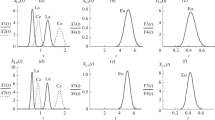Abstract
IN this communication, the possibility is considered of multiplying a single, electrolytic isotopic separation effect in a continuous process occurring in an electrolyser with a countercurrent flow and conversion of two immiscible liquid phases. The latter consisted of an electrode and an electrolyte. Such a process may—among other applications—be used to the enrichment of lithium. The process is presented schematically in Fig. 1. A solution of the lithium salt chosen is electrolysed during the flow between the immovable anode 1, and the movable cathode 2, which is mercury flowing in countercurrent. During the flow the isotopically enriched lithium is accumulated in the mercury. The resulting amalgam is then decomposed in the converter 3. The solution of the lithium salt obtained and the pure mercury are turned back to the electrolyser. Part of the solution of the salt in the converter can be taken off as the enriched product P. The dilute and isotopically exhausted electrolyte is removed from the device, which, owing to the apparent analogy, may be called the electrolytic column.
Similar content being viewed by others
Author information
Authors and Affiliations
Rights and permissions
About this article
Cite this article
SELECKI, A. An Electrolytic Countercurrent Column for Isotope Separation: a Simplified Theoretical Approximation. Nature 201, 61–62 (1964). https://doi.org/10.1038/201061c0
Issue Date:
DOI: https://doi.org/10.1038/201061c0
- Springer Nature Limited





